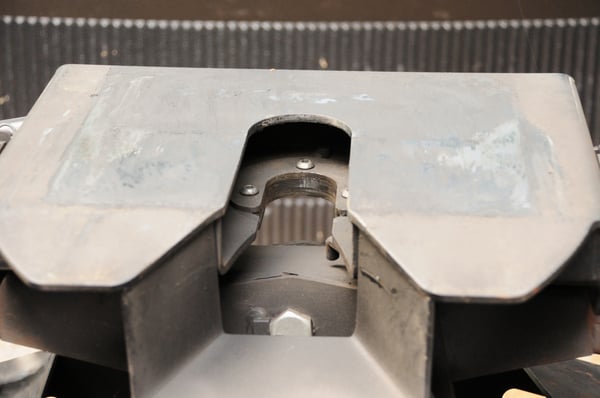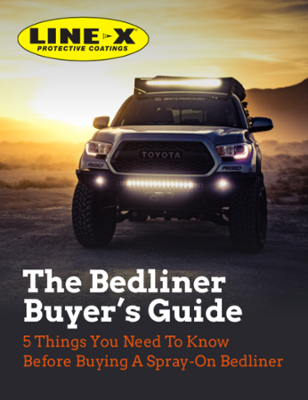You are looking into buying a big RV trailer, stock trailer, or toy hauler. You already know a bumper pull is not going to cut it, and that you need a heavy-duty hitch. You may, however, be confused between a gooseneck hitch and a 5th wheel hitch. They're very similar, and you may not know how to go about choosing. Here is an explanation of the similarities and differences that could help you out.
What do they Have in Common?
Fifth wheel and gooseneck hitches have many things in common and differ significantly from bumper pull hitches (your typical tow hook). Here is what they have in common:
- They take up space in the bed of your pickup truck.
- They are more stable than a bumper pull and make the towing vehicle easier to drive.
- They offer a significantly higher towing capacity. Bumper pull hitches are limited because of their reliance on the strength of the frame below the rear bumper.
- Because the trailer is connected toward the center of the vehicle, they can make tighter turns.
- They require a truck weight capacity of at least 3/4 ton, mostly because of the size of the trailers involved.
Both hitches are, again, intended for heavy-duty use. You should choose the type of hitch you need based on your lifestyle and the type of vehicle you intend to tow. Understanding the differences can help you make the right choice for the activities you are engaging in and where you are driving.
What Is a Gooseneck Hitch?
A gooseneck hitch is a ball hitch that looks similar to a traditional bumper pull , but is instead located in the center of the truck bed. The gooseneck ball connects to a coupler on the trailer hitch. It is attached to a fixed location in the truck bed, and brings the hitch in front of the rear axle. This provides a great combination of stability and flexibility. It is connected directly to the frame of the truck.
What Are the Advantages of a Gooseneck Trailer?
There are several advantages of a gooseneck trailer over a 5th wheel trailer:
- A gooseneck takes up much less of your trailer bed, and some designs can fold down into the trailer bed when not in use. You can even keep some limited storage space in the bed of your truck while towing.
- Goosenecks have the highest towing capacity, with many supporting a weight of up to 30,000 pounds. For most recreational uses, this is higher than needed and reflects the common usage of this hitch in industrial contexts.
- Gooseneck hitches are attached using separate brackets and are easy to remove and store.
- The gooseneck hitch offers greater freedom of movement for the tow vehicle, and not just laterally, but up and down. This makes it the best hitch if you are going to be taking the vehicle off-road or into poor road conditions.
- Gooseneck hitches are cheaper, although some don't come with all the brackets needed.
What Is a Fifth Wheel?
A fifth wheel trailer hitch is similar to the connectors used on semi-trucks and flatbeds. It's basically a large, flat, horseshoe-shaped plate. The trailer connects using a kingpin, which is a downward-facing pin that locks into the center of the plate. The kingpin is attached to an upside-down hitch plate. The plate connects to the truck bed with metal rails, which directly connects to the frame of the truck.
What Are the Advantages of a Fifth Wheel?
There are, however, also several advantages of a fifth wheel over a gooseneck:
- Fifth wheels come in one piece, which makes them easier to install.
- The connection location of a fifth wheel is not fixed, allowing you to adjust its position and meaning that most fifth wheels and fifth wheel trailers can work with multiple wheelbases.
- A fifth wheel offers a much smoother ride. In fact, gooseneck hitches are not legal for passenger transportation in most states, while fifth wheels are. Fifth wheels provide solid comfort to anyone riding in the trailer. This makes fifth wheels more popular for campers, RVs, or other travel trailers where it is not uncommon for somebody to want to ride or even sleep in the trailer.

The most significant disadvantage of a fifth wheel hitch is the amount of space it takes up in the truck bed. Because fifth wheel hitches are heavy, they can be challenging to remove. The Andersen Ultimate 5th Wheel Connection addresses this. It's rated for 24,000 pounds, which is about the max weight of the trailer for a fifth wheel but weighs only seventy pounds and thus can be removed by a single person.
The choice as to whether to use a fifth wheel or a gooseneck depends on your specific use case. Here are some examples:
- If you need a very high towing capacity, then you need a gooseneck. Bear in mind, however, that most recreational trailers are closer to 10,000 pounds. You should also check the payload capacity of your vehicle, as the hitch puts weight on the bed of the truck.
- If you intend to transport passengers or allow anyone to ride in the trailer, the law requires a fifth wheel.
- If you intend to go off-road, you need a gooseneck.
- Most RVs are fifth wheel, not gooseneck. Most horse trailers are goosenecks. Toy haulers tend to be fifth wheel, but gooseneck ones are available and may work well if you are hauling ATVs or off-road bikes.
You can sometimes get a hitch adapter that allows you to easily change between the two if you have multiple trailers. However, this can void the warranty on your hitch, so be careful, and adapters often reduce towing capacity. Make sure that you don't go by the 'dry weight' of a trailer, as that assumes the trailer is empty.
If in doubt, you should talk to an expert. Trailer and truck dealers can often help you work out whether the trailer you are looking at is compatible with the truck you have, or vice versa. Line-X of Louisville specializes in providing a variety of truck updates, including gooseneck and fifth wheel hitches. We can help you decide which one is better suited for your lifestyle and the kind of vehicle you intend to tow. Contact us to get a quote today.





